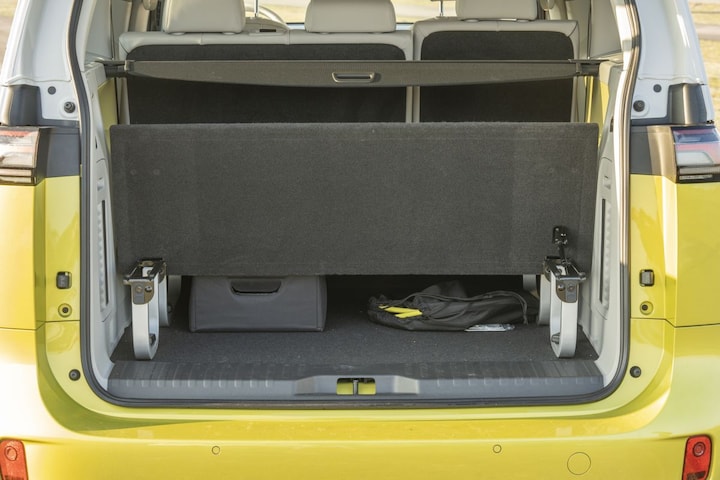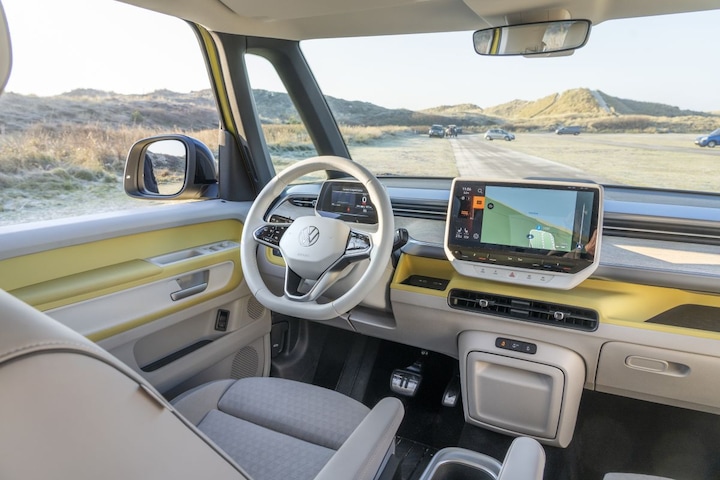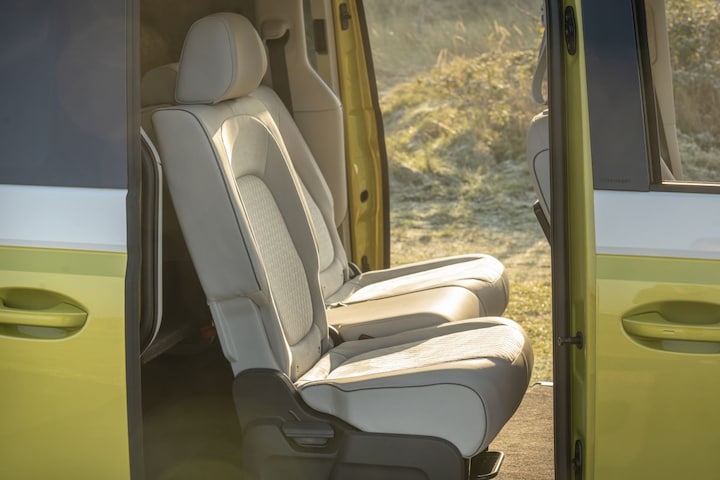Electric into space

Our patience was tested for years, but after many concept cars and study models, it is finally here: the new retro van from Volkswagen. The electric ID Buzz immediately creates its own segment, somewhere between delivery van and passenger car. Does it offer the best of both worlds, or has it become the sum of many compromises? That’s what we’ll find out in this test.
Hurrah! There is a new Volkswagen van!
Although the Volkswagen bus has of course never left. Volkswagen Commercial Vehicles offers a wide choice of vans, from Caddy via Transporter 6.1 to Crafter. But we understand the revelry, because the new ID Buzz with its (optional) two-tone paint, three strips on the C-pillars (similar to the cooling fins of yesteryear), large VW logo and classic V-shape of the nose is of course strong think of the old Spijlbus (T1) and Panoramabus (T2).
At the same time, the ID Buzz is simply itself. The headlights, taillights and interior blend seamlessly with the other members of VW’s electric ID family, while the nose is clearly more slanted than on the original buses. After all, in those cars, the driver and passenger sat on the front axle, with their knees just behind the headlights. Not good for safety – and also not for aerodynamics – so Volkswagen looked for a way to combine a straight front with front seats placed further back.
This results in a shape that also makes the ID Buzz recognizable in a more subtle color scheme. It has a length of 4.71 meters and a wheelbase of almost 3 meters. As a result, the ID Buzz is considerably larger than, for example, the ID 4. But because the wheels are on the extreme corners, the Buzz still looks compact.

It looks compact, but is of course very spacious.
Does the interior of the ID Buzz also take you back in time?
The Volkswagen designers have incorporated a funny ‘Easter eggs’ in the interior here and there that refer to the illustrious past of the Volkswagen bus, and the light use of color can also be seen as a reference to the classic vans. But otherwise the interior is mainly a journey towards the future. As we know from other ID models, the operation is largely digitized. Behind the wheel is a beautiful display on which the most important information can be read, a large central screen for operation and touch-sensitive ‘buttons’ on the steering wheel for, among other things, cruise control. But all this digital also causes irritation. The operation of the climate control, for example, is unnecessarily cumbersome and the Volkswagen software is no stranger to some interference. For example, we regularly have to deal with a ‘safety interruption’ on the way, which makes it temporarily impossible to operate the screen. That may sound safe, but in practice it only means more distraction. If we look at the use of materials, we encounter a lot of hard, but beautifully finished plastic.

It looks nice, but the materials are disappointing.
So the Volkswagen ID Buzz is a real space miracle?
In addition to the Cargo – a real van with a gray license plate – the ID Buzz is available as a passenger car with space for five occupants. That will change later, as the test car already shows. There are already armrests and cup holders in the side walls of the trunk. In addition to this ‘short’ version, there will also be a variant with an even longer wheelbase.
The ID Buzz has two sliding doors that provide ample access to the rear seat. Indeed: it is a conventional bench with a backrest that folds down in two parts, instead of three separate seats as in the Volkswagen Multivan, for example. As a result, the ID Buzz does not offer the flexibility that you would expect from such an MPV-like model.
But it is certainly not tight on board the ID Buzz. You can sit comfortably in the front, and the sliding rear seat offers ample space for three people (or child seats). By passenger car standards, it is unprecedented how much stuff disappears behind the gigantic tailgate. There is 1,121 liters of luggage in the back, and then the rear seats are not even folded down. It is striking how Volkswagen creates a flat loading floor when the bench is not used. Partly due to the battery pack, it can of course not disappear into the floor. Therefore, Volkswagen has chosen to raise the floor of the luggage compartment. That slides through more easily, but at the same time also costs a lot of usable stacking space. The raised bottom can be removed, but for that you have to unscrew a set of bolts on both sides. Then again, that’s a bit silly. With the rear seats flat, about 2,200 liters of luggage can be transported. And if that’s not enough, you can always hook a trailer with a maximum weight of 1,000 kilos to the towbar.

Lots of space and sliding seats.
But with its electric drive, the ID Buzz is of course very fast.
Technically there are major similarities with the Volkswagen ID 4. The Buzz is on the well-known modular MEB platform, which all other electric models from Volkswagen also use – just like the Skoda Enyaq iV, Cupra Born and Audi Q4 e-tron. The ID Buzz has the 77 kWh battery pack and the 204 hp electric motor of, among others, the ID 4. That engine, like the old VW vans with boxer engine, is located between the rear wheels. Good for traction – and it makes the ID Buzz historically sound. For the time being, the ID Buzz is only available with this 77 kWh battery and 204 hp electric motor.
The performance of the ID Buzz is what you can expect from such a large, 2,397 kilo weighing and above all practically furnished passenger bus. It accelerates from standstill to 100 km/h in 10 seconds, and the top speed is limited to 145 km/h. The ID Buzz is therefore not a speed monster. But with a car like this, you don’t want to run out of power as quickly as possible. During the test period we noted a consumption of 25.5 kWh/100 km, with the cold outside temperature (-2 degrees Celsius) certainly not helping. Volkswagen promises a range of 410 kilometers according to WLTP standards. We did not get further than 301 kilometers on a full battery.
Does that still drive a bit funny, such a Volkswagen ID Buzz?
When you get behind the wheel for the first time, it takes some getting used to. Not because of the high seating position, but mainly because of the extremely deep dashboard. Due to the fairly straight front of the ID Buzz, an enormous distance had to be bridged to the windshield. In practical terms, the space that has been created is of no use to you. Above all, it gives a feeling of spaciousness.
Now you are not as high in the ID Buzz as in competing electric models – Mercedes EQV, Citroën ë-SpaceTourer, Opel Zafira Life Electric and the like – which were basically developed as a van. Compared to the steering wheel and pedals, we even sit downright well, helped by the fine armrests on either side of the front seats. Because of the many glass you have a good overview of the traffic around you.
You don’t have to start yourself. Get in and drive away, just like in a Tesla. The ID Buzz weighs almost 2,400 kilos, but we hardly notice it on the road. Because the batteries are integrated into the floor, the center of gravity is nice and low and the car feels surprisingly light-footed. Another nice side effect of the MEB design: the turning circle is pleasantly small.

No frunk, here is only the filling opening for the windshield washer fluid.
There is no ‘one pedal driving’: without braking, the car never comes to a complete stop. The extent to which automatic braking is applied can only be regulated by switching between ‘D’ and ‘B’ with the button on the right behind the steering wheel. Indeed, just like the ID.3 and ID.4. The ID Buzz does not drive at all like one of those models. The huge sound box in the back also produces some light drone here and there, while the car has a somewhat bumpy character on short bumps. But that’s almost inevitable on a vehicle of these proportions.
What do you actually pay for such an ID Buzz?
Let’s first say that the ID Buzz is currently only available in two introductory versions: the 1ST and the 1ST Max. They are quite complete as standard. Alloy wheels in 20 or 21 inches, LED matrix headlights with adaptive high beam assist, seat and steering wheel heating, special upholstery and a multimedia package with navigation, voice control and a wireless phone charger are all included in the price. The safety equipment is also generous: adaptive cruise control, a reversing camera (the Max has a 360-degree camera), a blind spot sensor, traffic jam assistance and emergency assist are all supplied ex works. All this softens the starting price of more than 71,000 euros somewhat.
Again: these are the introductory versions of the ID Buzz. In time, versions will be available for a more friendly price. The equipment will be a lot less complete.
The choice of AutoWeek Test Coordinator Marco Gorter
When it comes to powertrains, there is nothing to choose from, there is a battery and a motor. The choice is also limited with the trim levels, there are two. Actually, the loafer is already equipped with everything you could want. Nice and clear.
.
– Thanks for information from Autoweek.nl